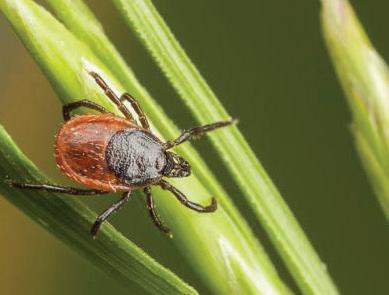
2 minute read
Tick Talk: Fighting the spread of tick-borne pathogens Emerging tick-borne disease-causing agents go undetected by current monitoring efforts

Ilia Shareghi Contributor
Advertisement
The prevalence of several tick-borne pathogens, which are living organisms or viruses that spread disease, are on the rise in Canada, including the bacterium responsible for Lyme disease. Evidence has also shown that these tick-borne pathogens have spread beyond the defined “risk areas” identified by professor Virginie Millien, an associate professor of biology and curator at the Redpath Museum. This makes it difficult to keep up with the pathogenic spread.
Lyme disease is Canada’s most common vector-borne disease, creating serious health concerns for people across the country. Tracking these ticks and thus their pathogens can help us follow the spread of Lyme disease and keep the illness under control.
“In vector-borne disease, there [are] many actors, and you need a host, a vector, and a pathogen, and so that makes a triangle,” Millien explained in an interview with The McGill Tribune . “Pathogens are transmitted by a vector species, which then will feed on a host, and that’s where the pathogen can then multiply and so on.”
In order for the tick—the vector—to move on to its next life stage, it must have a blood meal, which is when ticks feed on other animals. During a blood meal, the tick remains attached to the host and transfers pathogens into their bloodstream. Millien said these pathogens could then be transmitted back to new ticks if they feed on the infected host later.
According to Millien, the winter months are crucial to limiting a tick population’s ability to survive in a region. With global warming, however, many of the hosts that the ticks depend on, such as the white-footed mouse, are migrating farther north. The white-footed mouse is an effective host, able to re-transmit the pathogen to any new tick feeding on it 80 to 90 per cent of the time. Milien also explained that since mice are generalists—able to adapt to many different environments—they are prime vectors for disease.
Each mouse can feed hundreds of ticks over its lifetime, accelerating the pathogenic spread. As white-footed mice travel and settle farther north, the ticks travel with them, establishing themselves in new places and creating new areas for Lyme disease to emerge.
Another way in which tick-borne pathogens have become more prevalent across Canada is through migratory birds carrying ticks from south of the border into Canada.
“There are still areas north of the St. Lawrence where we see ticks and there’s Lyme disease there, but it’s not our own— it’s been brought in every year by birds,” Millien said.
Millen explained that the challenge of keeping track of ticks is both spatial and temporal. For example, predicting white-footed mice distribution on a map is difficult, as there are always individual mice that travel to unexpected areas like urban centres. The challenge is also temporal because Lyme disease is spreading more rapidly than Millien’s current models predict.
“We’re discovering that it’s happening much faster than anticipated,” Millien said. “Ten years ago, we had some models, but it looks like Lyme disease is appearing in places that we didn’t think it would be [....] It’s really challenging to obtain enough data to have a good estimate and be able to make some accurate predictions of the next decade.”
Deducing the future movements of infected white-footed mice is pressing. Millien explained that the data collected is “opportunistic, noisy, and unsystematic,” meaning that there will be little useful data to analyze. However, since ticks in general cannot live in areas where the temperature routinely drops below -14 degrees Celsius, a solution could be to propose new “risk areas” that encompass regions where the weather is above that temperature.
To combat these diseasespreading ticks directly, insect repellent is advised to reduce the chances of a tick bite. However, the root of the problem lies in climate change—addressing the issues caused by a heating world will also inhibit Lyme disease spread by cornering off its vectors.







